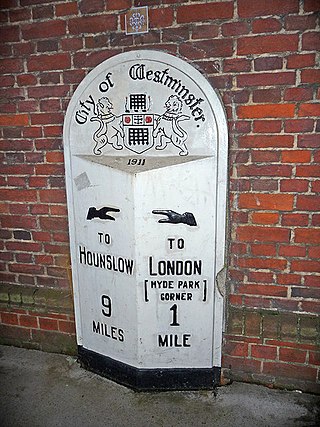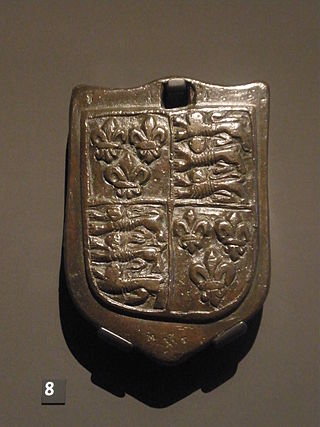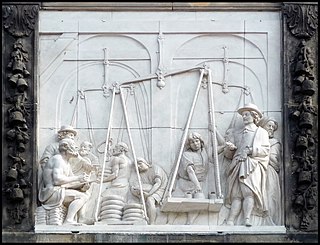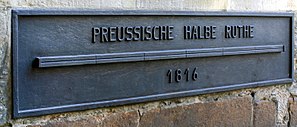
The mile, sometimes the international mile or statute mile to distinguish it from other miles, is a British imperial unit and United States customary unit of distance; both are based on the older English unit of length equal to 5,280 English feet, or 1,760 yards. The statute mile was standardised between the Commonwealth of Nations and the United States by an international agreement in 1959, when it was formally redefined with respect to SI units as exactly 1,609.344 metres.

In recipes, quantities of ingredients may be specified by mass, by volume, or by count.
The ounce is any of several different units of mass, weight, or volume and is derived almost unchanged from the uncia, an Ancient Roman unit of measurement.
The quart is an English unit of volume equal to a quarter of a gallon. Three kinds of quarts are currently used: the liquid quart and dry quart of the US customary system and the imperial quart of the British imperial system. All are roughly equal to one liter. It is divided into two pints or four cups. Historically, the exact size of the quart has varied with the different values of gallons over time and in reference to different commodities.

The stone or stone weight is an English and British imperial unit of mass equal to 14 pounds (6.35 kg). The stone continues in customary use in the United Kingdom for body weight.

The apothecaries' system, or apothecaries' weights and measures, is a historical system of mass and volume units that were used by physicians and apothecaries for medical prescriptions and also sometimes by scientists. The English version of the system is closely related to the English troy system of weights, the pound and grain being exactly the same in both. It divides a pound into 12 ounces, an ounce into 8 drachms, and a drachm into 3 scruples of 20 grains each. This exact form of the system was used in the United Kingdom; in some of its former colonies, it survived well into the 20th century. The apothecaries' system of measures is a similar system of volume units based on the fluid ounce. For a long time, medical recipes were written in Latin, often using special symbols to denote weights and measures.
The following systems arose from earlier systems, and in many cases utilise parts of much older systems. For the most part they were used to varying degrees in the Middle Ages and surrounding time periods. Some of these systems found their way into later systems, such as the Imperial system and even SI.
A league is a unit of length. It was common in Europe and Latin America, but is no longer an official unit in any nation. Derived from an ancient Celtic unit and adopted by the Romans as the leuga, the league became a common unit of measurement throughout western Europe. Since the Middle Ages, many values have been specified in several countries.

The Lot was a unit of measurement of mass, which was mainly used in German-speaking states of the Holy Roman Empire and in Scandinavia.
English units were the units of measurement used in England up to 1826, which evolved as a combination of the Anglo-Saxon and Roman systems of units. Various standards have applied to English units at different times, in different places, and for different applications.

The Dutch units of measurement used today are those of the metric system. Before the 19th century, a wide variety of different weights and measures were used by the various Dutch towns and provinces. Despite the country's small size, there was a lack of uniformity. During the Dutch Golden Age, these weights and measures accompanied the Dutch to the farthest corners of their colonial empire, including South Africa, New Amsterdam and the Dutch East Indies. Units of weight included the pond, ons and last. There was also an apothecaries' system of weights. The mijl and roede were measurements of distance. Smaller distances were measured in units based on parts of the body – the el, the voet, the palm and the duim. Area was measured by the morgen, hont, roede and voet. Units of volume included the okshoofd, aam, anker, stoop, and mingel. At the start of the 19th century the Dutch adopted a unified metric system, but it was based on a modified version of the metric system, different from the system used today. In 1869, this was realigned with the international metric system. These old units of measurement have disappeared, but they remain a colourful legacy of the Netherlands' maritime and commercial importance and survive today in a number of Dutch sayings and expressions.
The lachter was a common unit of length used in the mining industry in Europe, usually to measure depth, tunnel driving and the size of mining fields; it was also used for contract work. In most German-speaking mining fields it was the most important unit of length.
A number of units of measurement were used in Estonia to measure length, mass, area, capacity, etc.
A number of units of measurement were used in Hungary to measure length, area, volume, and so on. The metric system was adopted in Hungary in 1874 and has been compulsory since 1876.
A number of units of measurements were used in Latvia to measure length, mass, area, and so on. Russian and local measures were used since 1845, and the former system before those, was that of the Netherlands.
A number of units of measurement were used in Mexico to measure length, mass, area, capacity, etc. The Metric system was optional from 1857, and has been compulsory since 1896.
A number of different units of measurement were used in Libya to measure length, mass, area, etc. The metric system was adopted in Libya in 1927.
A number of units of measurement were used in South Africa to measure quantities like length, mass, capacity, etc. The Imperial system of measurements was made standard in 1922 and the metric system was adopted in 1970.
A number of units of measurement were used in Venezuela to measure quantities like length, mass, etc. Metric system was optional in Venezuela since 1857, and has been compulsory since 1914.
A Münzfuß is an historical term, used especially in the Holy Roman Empire, for an official minting or coinage standard that determines how many coins of a given type were to be struck from a specified unit of weight of precious metal. The Münzfuß, or Fuß ("foot") for short in numismatics, determined a coin's fineness, i.e. how much of a precious metal it would contain. Mintmaster Julian Eberhard Volckmar Claus defined the standard in his 1753 work, Kurzgefaßte Anleitung zum Probieren und Münzen, as follows: "The appropriate proportion of metals and the weight of the coin, measured according to their internal and external worth, or determined according to their quality, additives and fineness, number and weight, is called the Münzfuß."





